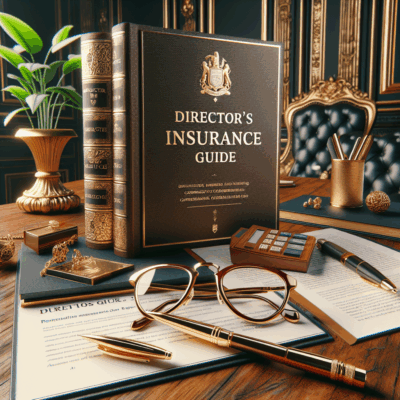Understanding Directors Insurance Premiums: An Impartial Guide to Protecting Your Leadership
Serving as a director or officer of a company is a position of immense responsibility and, consequently, significant risk. The decisions made in the boardroom can have far-reaching consequences, potentially leading to legal actions from shareholders, employees, regulators, or competitors. In this litigious environment, Directors and Officers (D&O) insurance has become a non-negotiable safeguard for both the individuals in leadership and the organization itself. However, navigating the complexities of a D&O policy, particularly understanding what drives the directors insurance premium, can be a daunting task. This article provides a comprehensive, impartial deep dive into the factors that determine your premium and offers a structured framework to effectively compare insurance policies, ensuring you secure the right protection without overpaying.
What Exactly is Directors and Officers (D&O) Insurance?
Before dissecting the premium, it’s crucial to understand the product itself. D&O insurance is a liability coverage designed to protect the personal assets of a company’s directors, officers, and sometimes, employees, in the event they are sued for alleged wrongful acts while managing the company. These “wrongful acts” can include:
- Breach of Fiduciary Duty: Allegations of failing to act in the best interest of the company.
- Misrepresentation: Inaccurate statements in prospectuses or financial reports.
- Errors in Judgment: Poor strategic decisions that lead to financial loss.
- Failure to Comply with Laws or Regulations: Violations of workplace, environmental, or securities laws.
- Employment Practices Issues: Though often covered by separate EPLI, some D&O policies may respond to claims like wrongful termination.
A D&O policy typically has three insuring agreements, commonly referred to as “Sides”:
- Side A: Covers directors and officers directly when the company cannot indemnify them (e.g., if the company is bankrupt or legally prohibited from doing so).
- Side B: Reimburses the corporation when it does indemnify its directors and officers for defense costs, settlements, or judgments.
- Side C: Provides coverage for the corporate entity itself, particularly relevant in securities claims for publicly traded companies.
The cost of this protection bundle is the directors insurance premium.
The Key Factors That Determine Your Directors Insurance Premium
Insurance carriers employ sophisticated actuarial models to assess risk. Your premium is not a random number; it is a carefully calculated reflection of your company’s specific risk profile. Here are the primary factors underwriters evaluate:
1. Company Size and Financial Health
This is a fundamental starting point. Larger companies generally face higher premiums because the potential scale of a lawsuit is greater.
- Revenue: A company with $500 million in revenue presents a larger target than a $5 million startup. Higher revenue often correlates with more complex operations and a larger number of stakeholders.
- Market Capitalization (for public companies): This is a critical metric. A higher market cap means more shares are outstanding, so a securities class-action lawsuit could involve a vast number of shareholders and enormous potential damages.
- Profitability and Cash Flow: A company with strong, consistent profits and healthy cash flow is viewed as more stable and less risky than one struggling financially. Financial distress can lead to desperate measures and, subsequently, lawsuits from creditors or investors.
2. Industry and Risk Profile
The sector in which your company operates is a massive premium determinant. Some industries are inherently more litigious than others.
- High-Risk Industries: Biotechnology, pharmaceuticals, financial services, healthcare, and technology are typically considered high-risk. They face intense regulatory scrutiny, the potential for product liability, volatile stock prices (for public companies), and complex intellectual property disputes.
- Medium-Risk Industries: Manufacturing, retail, and professional services often fall into this category.
- Lower-Risk Industries: Non-profits and privately held companies in less volatile sectors may enjoy lower premiums, though their need for protection is still very real.
3. Claims History
Perhaps the most significant factor after industry is your company’s past. A history of D&O claims is a huge red flag for insurers.
- Frequency and Severity: Underwriters will want to know about every claim made in the last 5-10 years. A single, large, well-managed claim might be less damaging than a pattern of frequent, smaller claims, which suggests systemic governance issues.
-
Circumstances of Past Claims: The nature of the past claims matters. A history of employment practices claims might be mitigated by implementing new HR policies, while a history of securities fraud allegations is far more serious.
4. Corporate Governance Practices
Insurers aren’t just betting on your past; they’re betting on your company’s leadership and structure. Strong governance is a key mitigator of risk.
- Board Composition: Is the board diverse in skills and experience? Are there independent directors? A board that challenges management and provides robust oversight is seen favorably.
- Internal Controls: Does the company have strong financial controls, audit committees, and risk management protocols? Documented procedures for compliance, whistleblowing, and ethical conduct are essential.
- Experience of Directors and Officers: A management team with a proven track record of success and integrity can be a positive factor.
5. Coverage Specifics and Policy Structure
The choices you make in designing the policy directly impact the price.
- Limits of Liability: This is the maximum amount the insurer will pay. Higher limits equal higher premiums. Choosing an appropriate limit is a critical balance between risk exposure and cost.
- Deductibles (Retentions): This is the amount the company must pay out-of-pocket before the insurance kicks in. Opting for a higher deductible can significantly reduce your premium, as the insurer takes on less initial risk.
- Policy Terms and Exclusions: Broader coverage with fewer exclusions will cost more. It’s vital to understand what is excluded from the policy (e.g., fraud, bodily injury, property damage, certain prior acts).
6. Company Status: Public, Private, or Non-Profit
- Public Companies: Face the highest exposure due to securities litigation risk. Their premiums are typically the highest and are heavily influenced by stock volatility and trading volume.
- Private Companies: While generally lower risk than public companies, they are not immune to suits from vendors, creditors, or investors. Premiums have been rising as litigation against private companies increases.
- Non-Profit Organizations: Can be sued by donors, beneficiaries, or regulators. Their premiums are usually lower but the need for protection is critical due to often limited resources.
How to Impartially Compare Insurance Policies (we do this as standard by the way)
Simply looking at the bottom-line premium is the worst way to purchase D&O insurance. A cheaper policy might be cheap for a reason—offering less coverage. To make a truly informed decision, you must compare insurance policies on a like-for-like basis. Here is a step-by-step guide:
1. Scrutinize the Insuring Agreement
Don’t just check the box that says “Side A, B, and C.” Read the wording. Does the policy define “Wrongful Act” broadly? Are there any sneaky sub-limits hidden in the fine print that cap coverage for certain types of claims, like regulatory investigations? A robust policy will have clear, broad language.
2. Analyze the Exclusions Thoroughly
This is where policies truly differ. The “Bodily Injury/Property Damage” exclusion is standard, as those are covered under other policies. Pay close attention to:
- The Insured vs. Insured Exclusion: Standard policies exclude claims brought by one insured against another (e.g., a director suing the company). However, good policies will include carve-backs, allowing for coverage in common scenarios like employment practices claims brought by a former officer or derivative suits brought by shareholders.
- The Conduct Exclusion: This excludes claims arising from fraudulent, criminal, or deliberately dishonest acts. However, the policy should still provide defense costs up until a final adjudication of such conduct.
- Prior Acts Date: Ensure the policy covers claims arising from acts that occurred after a specified “prior acts” date. You want this date to be continuous with your previous policy to avoid coverage gaps.
3. Compare the Strength of the Carrier
The cheapest premium is worthless if the insurer lacks the financial strength or claims-paying ability to be there when you need them.
- Financial Ratings: Check the ratings from independent agencies like A.M. Best, Standard & Poor’s, and Moody’s. Only consider carriers with an “A” rating or higher.
- Claims Handling Reputation: Your broker can provide insight into which insurers are known for fair and efficient claims handling versus those that are notoriously difficult. The claims process is not the time to discover your insurer is adversarial.
4. Evaluate the Defense Provisions
How a policy handles defense costs is critical.
- Duty to Defend vs. Reimbursement: A “duty to defend” policy means the insurer controls the legal defense and chooses the lawyers. A “reimbursement” policy means you choose your counsel (subject to insurer consent) and are reimbursed for costs. Most D&O policies are reimbursement, which is generally preferred as it allows you to control your defense.
- Advancement of Defense Costs: The policy should explicitly state that defense costs are advanced as they are incurred, not reimbursed only after a claim is settled.
5. Engage a Specialized Broker Just Like Us (We Specialise In This Don’t You Know)
This is the most important step. An experienced, independent commercial insurance broker who specializes in D&O liability is an invaluable asset. They act as your guide and advocate and without blowing our own trumpet we’re damn good at it. Try us and see for yourself as we work for you and are impartial.
- Market Access: They have relationships with multiple A-rated carriers and can market your risk to the most appropriate insurers.
- Negotiation Power: They understand policy wording and can negotiate better terms, broader coverage, and more competitive premiums on your behalf.
- Impartial Advice: A good broker provides an impartial analysis of the options, clearly explaining the trade-offs between cost and coverage to help you make the best decision for your organization.
Conclusion: Beyond the Premium – An Investment in Governance
Viewing the directors insurance premium solely as a cost is a short-sighted approach. It should be reframed as a critical investment in your company’s governance and a necessary tool for attracting and retaining top-tier talent. Savvy directors will often refuse to join a board without the assurance of robust D&O coverage. By understanding the multifaceted factors that drive pricing and adopting a meticulous, impartial methodology to compare insurance proposals, you can secure a policy that provides true peace of mind. This ensures that your leaders are empowered to drive innovation and growth, protected from the potentially devastating personal financial consequences of litigation, and that the organization itself is fortified against existential threats. In the high-stakes arena of corporate leadership, a well-chosen D&O policy is not just insurance; it is a fundamental pillar of a resilient and responsible enterprise.
Frequently Asked Questions: Directors Insurance Premiums
Q: What is a directors insurance premium?
A: A directors insurance premium is the periodic cost, typically paid annually, for a Directors and Officers (D&O) liability insurance policy. This premium secures coverage that protects the personal assets of a company’s directors and officers from legal costs and damages arising from lawsuits related to their managerial decisions and actions.
Q: What factors influence the cost of a directors insurance premium?
A: Several key factors influence the cost, including the size and type of your company, its financial health, the industry sector and its associated risks, the amount of coverage (limit of liability) you choose, your claims history, and the company’s governance practices.
Q: Are directors insurance premiums tax-deductible?
A: In most cases, yes. Directors insurance premiums are generally considered an ordinary and necessary business expense and are therefore tax-deductible for the corporation. It is always recommended to consult with a tax professional or accountant for advice specific to your situation.
Q: How can we reduce our company’s directors insurance premium?
A: You can potentially reduce your premium by implementing strong risk management and corporate governance practices, maintaining accurate financial records, providing regular training for your board, shopping around and comparing quotes from different insurers, and opting for a higher deductible (excess).





